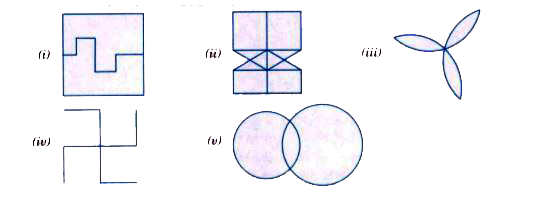Which of the following geometrical figures has exactly two lines of symmetry ? (i) A square (ii) A parallelogram (iii) An isosceles trapezium (iv) A rectangle
A square
A parallelogram
An isosceles trapezium
A rectangle
To determine which geometrical figure has exactly two lines of symmetry among the options given, we will analyze each figure step by step.
Step 1: Understand the concept of lines of symmetry
A line of symmetry is a line that divides a figure into two identical halves that are mirror images of each other.
Step 2: Analyze each figure
(i) A square
- A square has four lines of symmetry. These lines can be drawn vertically, horizontally, and along the two diagonals.
- Conclusion: A square does not have exactly two lines of symmetry.
(ii) A parallelogram
- A parallelogram has no lines of symmetry. No line can divide it into two equal halves that are mirror images.
- Conclusion: A parallelogram does not have any lines of symmetry.
(iii) An isosceles trapezium
- An isosceles trapezium has one line of symmetry. This line runs vertically down the middle, dividing the figure into two equal halves.
- Conclusion: An isosceles trapezium does not have exactly two lines of symmetry.
(iv) A rectangle
- A rectangle has two lines of symmetry. These lines are drawn vertically down the middle and horizontally across the middle.
- Conclusion: A rectangle has exactly two lines of symmetry.
Final Answer
The geometrical figure that has exactly two lines of symmetry is (iv) A rectangle.
---
A line of symmetry is a line that divides a figure into two identical halves that are mirror images of each other.
- A square has four lines of symmetry. These lines can be drawn vertically, horizontally, and along the two diagonals.
- Conclusion: A square does not have exactly two lines of symmetry.
- A parallelogram has no lines of symmetry. No line can divide it into two equal halves that are mirror images.
- Conclusion: A parallelogram does not have any lines of symmetry.
- An isosceles trapezium has one line of symmetry. This line runs vertically down the middle, dividing the figure into two equal halves.
- Conclusion: An isosceles trapezium does not have exactly two lines of symmetry.
- A rectangle has two lines of symmetry. These lines are drawn vertically down the middle and horizontally across the middle.
- Conclusion: A rectangle has exactly two lines of symmetry.
The geometrical figure that has exactly two lines of symmetry is (iv) A rectangle.
Topper's Solved these Questions
Similar Questions
Knowledge Check
Which of the following geometrical figures has exactly one line of symmetry ? (i) A rectangle (ii) A semi circle (iii) A regular pentagon (iv) A rhombus
AA rectangleBA semicircleCA regular pentagonDA rhombusWhich of the following figures has only one line of symmetry ?
AA rectangleBA parallelogramCAn isosceles trapeziumDA circle
State the number of lines of symmetry for the following figures: (i) An equilateral triangle (ii) An isosceles triangle
View SolutionDiagonals necessarily bisect opposite angles in a (a) rectangle (b) parallelogram (c) isosceles trapezium (d) square
View SolutionState the number of lines of symmetry for the following figures: (i) A scalene triangle (ii) A rectangle
View SolutionWhich of the following has an infinite number of lines of symmetry? (a) Equilateral triangle (b) Isosceles triangle (c) Regular hexagon (d) Circle
View SolutionWhat other name can give to the line of symmetry of (i) An isosceles triangle? (ii) A circle?
View SolutionExplain how a square is: a quadrilateral? (ii) a parallelogram? a rhombus? (iv) a rectangle?
View Solution

